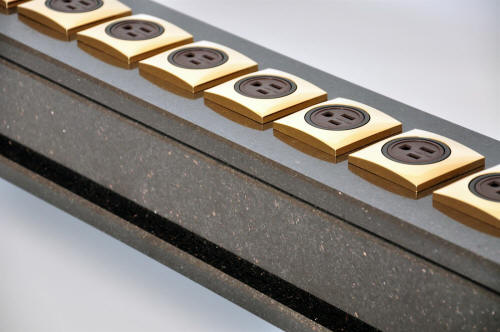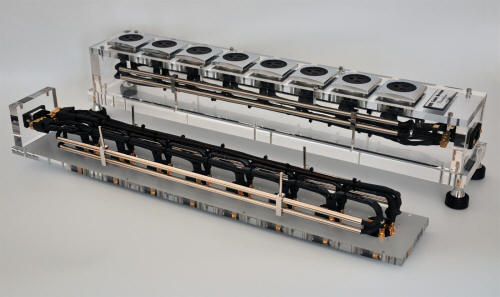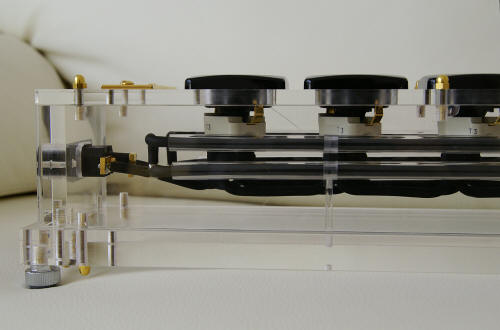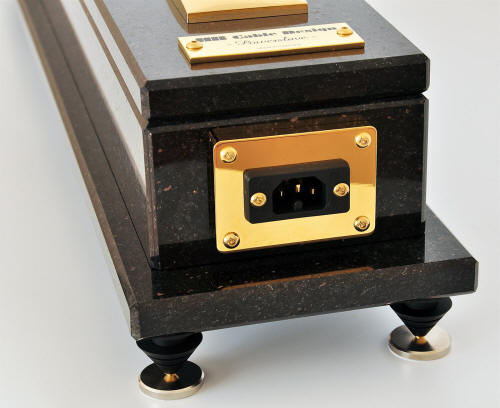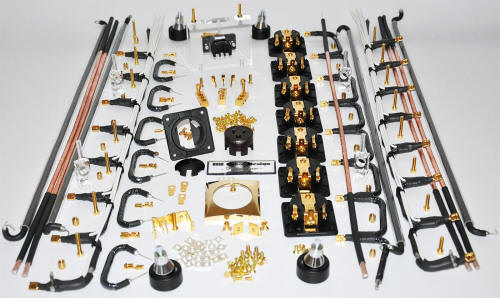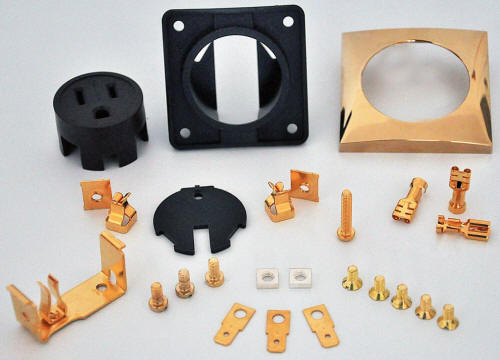|
|
You are reading the older HTML site
Positive Feedback ISSUE 72
hb cable design PowerSlave Marble Power Distributor as reviewed by Marshall Nack
Like most clubs, the audiophile agenda includes a couple of classic scenarios. What unfolded now was the familiar "I put on the first CD." It goes like this: "I put on the first CD just to let the system warm up while I casually went about my business working on the xxx (product) review. But, dang it, I couldn't stay focused on the page. My mind was lured by the siren call." No, this is not symptomatic of reviewer OCD. This particular script is one we all know—and even look forward to—because it indicates a potential breakthrough has occurred. I was listening to a recording of Mendelssohn Piano Concertos (PentaTone PTC 5186 366) via the Accuphase DP-600 SACD Player as a transport feeding the Metronome D6 DAC. Preamps were either the Trinity or Ypsilon PST 100. Cables were all KubalaSosna Elation!. These are lovely concertos, infrequently heard. (A recent harmonia mundi CD of some other Mendelssohn piano concertos is even better. Check out HMC902082.) The sound is big and dynamic, with good tone and timbre, and the piano is nicely integrated with the orchestra—everything we've come to expect from PentaTone engineering. But there are issues with this one: The orchestra is soft and mushy, especially the bass which is loose and bleeds into the midrange. When that happens, the fog rolls in and the soundscape becomes obscured—inner voices are lost. A Solid Foundation Let's get back to basics. When building a house, the first principle is to start with a solid foundation. That's what was missing—nothing felt solid. It was all shifting and blending, to a degree that it became difficult to discern individual players.
The HB Cable Design PowerSlave Marble Power Distributor affects an immediate Rx by putting in place the most solid foundation I've encountered. It begins by firming up the loose bass—actually, everything from 20–20kHz benefits from firming. The low frequencies became weighty, massive, and taut, and don't spread upwards into the lower midrange. Tone drops and becomes a bit darker, notes became dense and concentrated, what Lynn likes to call centered. A lot of the vague atmospheric effects some listeners call air were washed away. Yet, they are fully developed; timbres are quite fully realized. The firming particularly benefits articulation. Now I can pick out each woodwind and follow their lines; now I can "see" each instrument on the soundstage. Note that the Marble also imparts huge dollops of flesh and keeps images at full size. It firms without shrinking or getting lean—that's nice! What I'm saying is the Marble heightens definition and articulation while maintaining the beauty of the sound. There is no loss—only gain with this power distributor.
Appearance / Cosmetics "Wait until you see this one!" The importer had given me warning—the Marble's appearance must be reckoned with. On first look, I had the same reaction as with the Acrylic model. Gads, both of these HB PowerSlave products elicit the same response—shock and awe.
Apart from the luxurious black, gold-flecked, Italian marble chassis, the Marble is so large (29" L x 6.3" W x 4.3" H) and heavy (40 lbs), you know certain sonic properties will come into play, namely mass loading. The Shadowy Divide between Damped and Dull A little bit of damping from mass loading is a good thing. It usually imparts noise reduction, clarity, body, and more powerful sound. I've already addressed the increased clarity and body. But it's easy to slip down the rabbit hole into over-damped. Overdo mass loading just a little and the life-giving fluids are leached from the music-body. It becomes dull. Power, Support and Weight Well, that's not a problem for the Marble. There was no evidence of over-damping or suppression of musical flow. What I did hear was more powerful sound. This is integral to how the Marble constructs the solid foundation and is probably the first thing you will notice. Dynamics become crisp and contrasty, making the performance more energetic and engaging. The Unsolved Mystery of the Wandering Soloist On a side note, for the longest time I've had a problem with image drift. Violin or woodwind soloists refused to stay put. (The rest of the stage was rock steady.) It didn't matter what gear I was using: when the soloist played in the midrange, he was dead center. As he moved up the scale, the image would start to veer left. The higher up he played, the further left he imaged. He would not stay put, regardless of what I tried. Eventually I stopped fussing and just accepted that was the way it was.
Case in point, the Prokofieff Violin Concerto, with Heifetz and Munch conducting the Boston Symphony Orchestra (RCA shaded dog, LSC-2314). Finally, the Marble locked Heifetz in place. The violinist was close-up, obviously spot-miked, front and center, quite distinct from the orchestra. The orchestra was behind and on either side and encircled him in a hemisphere, and probably had one mike on each side, placed at a distance. I would never have imagined the problem of the wandering soloist had anything to do with AC power. BTW: analog playback was via the Vitus SP-102 Phono Stage and, I tell you, it loves being plugged into this power distributor, enjoying full range and robust response.
the Marble meets the Kraken The Marble needs a power cord with massive current capability. The importer made a point of noting that one would not be getting the full benefits with most power cords, even with top of the line ones like the K-S Elation! power cord I've been using.
I switched to his recommended power cord, the Stage 3 top model Kraken (MSRP $8400). A massive low-frequency foundation rolled in, a firmament capable of supporting an entire structure. The Kraken doesn't let anything get away and maintains complete control. It injects new-found potency and fleshiness throughout the frequency range, even as it quiets down the noise level. Those of us who could benefit from additional weight and dynamic slam will find both in spades with the addition of a single Kraken hooked up to this power distributor. You will be amazed. Design and Construction The HB is lined with natural noise-damping material and runs of proprietary conductor wire constructed from a hybrid of silver and copper. (The company has a highly regarded line of signal wires and power cords.) There are eight outlets and each receives a full, individual cable run.
The conductors are ensconced in multiple layers of dielectrics, which perform either dampening or shielding functions. The dielectrics are chosen depending on their usage—that is, where a particular wire will be deployed.
The AC outlets did not look familiar; they are custom made in Germany. The IEC plug is also of custom German manufacture. All of the contacts are solid copper or brass alloy with two-layer gold plating.
I was surprised there were different spikes supplied with the Marble from those that came with the Acrylic model. Upon inquiry, I was informed each HB PowerSlave has a different footer selected to complement each model's resonance. The Marble's matching spike plates are tiny making them a little difficult to position and keep in place should you move the unit.
Conclusion When you are building a house, you have to start with a solid foundation. The HB Cable Design PowerSlave Marble Distributor lays down the most solid foundation I've encountered. The Marble heightens the audiophile experience in many ways. At the same time, you do not lose any part of the music—it does it all. This is a product with no caveats to report! The bottom line is the same as for the HB Acrylic model I reviewed previously, but with an even more emphatic YES! If I had an unlimited budget, I'd sooner purchase the HB Marble than any power distributor or conditioner on the market. Marshall Nack
PowerSlave
Marble Distributor
HB Cable
Design Importer Aaudio Imports Parker, CO 80134 720-851-2525 www.aaudioimports.com
|










